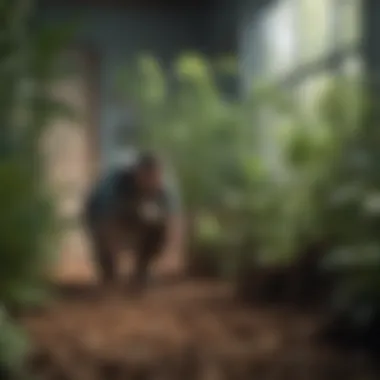Effective Strategies to Keep Ants Out of Your Plants


Intro
Design Inspiration
When considering how to keep ants away, it is helpful to explore design elements that focus on creating a deterrent environment while enhancing your garden's aesthetic.
Outdoor Structure
Creating barriers within the garden can be both functional and visually pleasing. A woven garden trellis can serve as a natural deterrent, as ants prefer to travel along the ground. Adding decorative stones or bricks can also form a boundary that disrupts their movement. This design not only helps to keep ants at bay but also adds a stylish touch to your outdoor space.
Plant Choices
Certain plants naturally repel ants. Incorporating herbs such as mint, lavender, and basil can discourage their presence. The strategic placement of these plants around vulnerable species will not only create a protective barrier but also enhance the fragrance of your garden. The visual appeal combined with the functional benefits provides a dual advantage.
Seasonal Considerations
The impact of seasons on ant behavior is notable. During warmer months, ants search for food sources within gardens. Planting during cooler seasons might confuse their foraging routes, temporarily reducing their numbers. Understanding the behavioral patterns of ants can guide planting schedules that minimize ant activity and encourage optimal growth.
Gardening Advice
The following section will discuss actionable advice on maintaining a garden that does not attract ants, ensuring a healthy ecosystem for your plants.
Seasonal Planting Guides
- Spring Planting: During this time, consider planting ant-repelling flowers. This can create a natural barrier against infestations.
- Summer Maintenance: Regularly check plants for aphids, as ants often protect these pests for their honeydew. Remove any infected plants promptly.
- Fall Preparation: Prepare the garden for warmer months. Clearing debris can eliminate potential ant nests and lessen their activity level in the following season.
Maintenance and Care Tips
- Keep garden beds dry, as ants are attracted to moist environments.
- Regularly inspect the soil for signs of ant activity.
- Use natural insecticidal soaps when necessary, targeting the plants most affected.
"By understanding ant behaviors and taking strategic steps, you can effectively protect your plants and enhance your garden’s health."
In synthesizing the information, the aim is clear. Keeping ants out of your plants requires a combination of strategic planting, careful maintenance, and a good understanding of ant behaviors. By taking these actionable steps, both novice and expert gardeners can create an environment that fosters plant growth without the intrusion of pests.
Understanding Ant Behaviors
Understanding the behaviors of ants is crucial for effective pest management in gardening. Ants play a complex role in the ecosystem. They interact with other organisms and can affect plant growth. Knowing their roles can help gardeners create strategies that deter ants while fostering healthy plants.
The Role of Ants in Ecosystems
Ants are not just pests; they are key players in many ecosystems. They help in soil aeration which improves plant health. Ants also aid in seed dispersal. This behavior enhances plant diversity. Moreover, ants can act as natural predators to some pests. They help regulate insect populations that might harm plants. Thus, while they may invade gardens, their overall impact is multifaceted.


Why Ants are Attracted to Plants
Ants are predominantly attracted to plants for several reasons. One primary factor is the availability of food sources. Flowers often produce nectar, which is a sweet substance ants love. Moreover, some plants release chemicals that may attract ants. Another reason is the presence of aphids and other pests that ants tend to farm. Ants protect these pests from natural predators, as they can harvest the honeydew produced by them. This relationship benefits both ants and the pests.
Understanding these dynamics helps gardeners to tailor their approaches in keeping ants away. It is essential to recognize that not all interactions between ants and plants are negative. By fostering a balance, gardeners can exploit the beneficial aspects of ants while minimizing their harmful behaviors.
Identifying Ant Infestations
Identifying ant infestations is critical for maintaining a healthy garden. Ants can cause significant harm to plants by protecting harmful pests like aphids. These relationships often go unnoticed until more severe damage occurs. Recognizing the early signs of an ant problem allows for timely intervention, which can prevent further complications and the potential decline of plant health. The focus is on identifying the conditions that contribute to ant invasions, as well as understanding their behaviors to inform control measures.
Signs of Ant Presence
Detecting ants in your garden can be challenging, but there are specific indicators to look for. Here are some of the most prevalent signs:
- Ant Trails: Observe areas where you find a steady stream of ants moving between plants or food sources. This often indicates a nearby nest.
- Nesting Sites: Ants build nests in soil, under rocks, or in decaying wood. Look for small openings or mounds of soil, particularly in warm weather.
- Feeding Habits: Inspect your plants for signs of damage, such as wilting leaves or visible pests like aphids. Ants often cultivate aphids for honeydew, a sweet substance they consume.
- Visible Ants: Simply spotting ants, especially in large numbers near a specific area, can suggest an infestation.
Recognizing these signs early is essential in managing ant populations effectively.
Common Ant Species in Gardens
Different species of ants can be found in gardens, each having distinct behaviors and impacts on plants. Here are a few common ones:
- Carpenter Ants: Typically larger, these ants can cause structural damage by hollowing out wood for nesting.
- Argentine Ants: These small black ants are notorious for forming large colonies and are attracted to sweet substances.
- Pavement Ants: Often found nesting in cracks of sidewalks, these ants can forage into gardens, usually in search of food.
To identify the species, consider the size, color, and behavior of the ants. Understanding the specific type of ant you are dealing with can guide your management strategies effectively.
Preventive Measures for Ant Control
Ants can quickly become significant problems in gardens if left unchecked. The best approach is to prevent infestations before they start. Implementing preventive measures is essential for maintaining the health of your plants and ensuring a thriving garden environment. By focusing on several specific strategies, you can make your garden less attractive to ants and maintain optimal plant health.
Creating a Barrier
Establishing a physical barrier is one of the simplest yet effective methods to keep ants away from your plants. This can involve placing materials that ants do not cross around your garden or individual plants. Common materials include diatomaceous earth, which is safe for plants but tough on ants, and sticky traps that catch ants while they attempt to cross. These barriers can deter ant pathways leading to your plants, making it harder for them to establish a presence.
Utilizing Natural Repellents
Using natural repellents offers a way to deter ants without introducing harmful chemicals to your garden. There are two highly effective natural solutions worth discussing.
Essential Oils
Essential oils, such as peppermint or tea tree oil, are potent repellents against ants. Their strong scent masks the pheromone trails ants follow, disrupting their foraging behavior. This quality makes these oils a popular choice for those seeking a natural solution. Essential oils can be diluted with water and sprayed around plants or mixed with carrier oils for application. While they are effective, their scent may fade over time, requiring reapplication.
Vinegar Solutions


Vinegar solutions are another effective option. The acetic acid in vinegar interferes with ant pheromones, making it difficult for them to communicate with each other. A solution of equal parts water and vinegar can be sprayed directly onto affected areas or around plant bases. This method is advantageous due to its simplicity and safety for plants. However, it's important to remember that vinegar’s effectiveness can diminish after rainfall or irrigation, necessitating frequent application to maintain its deterrent effect.
Physical Exclusion Techniques
Adopting physical exclusion techniques involves making changes to the immediate environment of your plants. This can include trimming back vegetation that may serve as bridges or pathways for ants. Keeping flower beds tidy and avoiding plant overcrowding can minimize hiding spots. Additionally, ensuring that mulch or ground cover does not touch plant stems may help prevent ants from nesting near your plants. Removing food sources, like spilled sugar or plant debris, will also discourage ants from frequenting your garden.
Protecting your plants now can save significant effort later. Choices made today in ant prevention can lead to healthier plants tomorrow.
By employing such preventive measures, you can substantially reduce the risk of ants invading your garden space. It is crucial to remain vigilant and to adjust strategies when necessary. This approach is key to fostering a balanced ecosystem in your garden.
Cultural Practices to Deter Ants
Cultural practices are critical for keeping the garden free from ants while promoting healthy plants. These practices shape the environment in a way that minimizes the factors contributing to ant attraction. By adopting appropriate growing techniques, gardeners can effectively reduce the likelihood of ant infestations.
Proper Watering Techniques
Watering is essential for plant health, but improper techniques can create conditions favorable for ants. Overwatering leads to soggy soils, attracting ants that seek moist environments. It is important to implement a watering schedule that keeps soil consistently moist but not waterlogged. Early morning watering is effective. This timing allows plants to absorb moisture throughout the day with minimal evaporation. Ensuring good drainage is also essential. This prevents water from pooling, making the area less appealing to ants.
Maintaining Soil Health
Healthy soil is crucial for plant vitality and can deter ants. Soil rich in organic matter supports beneficial microorganisms that create a less hospitable environment for ants. Regularly adding compost improves soil structure and nutrient content. Additionally, practicing crop rotation can disrupt ant patterns, as changing the plant types affects their food sources. Avoiding chemical fertilizers that disrupt soil ecosystems and opting for organic alternatives will further enhance soil health. Healthy plants entrust less stress, making them less attractive to pests.
Plant Selection and Arrangement
The types of plants in your garden significantly influence ant populations. Some plants naturally repel ants. For example, planting herbs like mint or basil nearby can deter these pests. Furthermore, careful arrangement of plants can limit access to certain areas. Grouping different plant species can create a diverse ecosystem. Ants tend to thrive in monocultures. Therefore, ∗variety in plant selection can curtail ant establishment. This also encourages beneficial insects that prey on ants. In addition, consider spacing plants appropriately to provide airflow and reduce moisture accumulation.
In summary, cultural practices shape the narrative of your garden. By integrating proper watering, maintaining soil health, and selecting appropriate plants, you create an ecosystem less inviting to ants. This approach promotes not just the health of your plants but the overall balance of your garden environment.
Chemical Solutions for Ant Management
Chemical solutions can play an important role in managing ants effectively in your garden. While many gardeners prefer natural methods, there are times when chemical interventions become necessary. Chemical solutions can help eliminate infestations quickly and can be particularly useful for severe problems that other methods cannot resolve. When utilized correctly, these solutions can protect your plants and ensure that they remain healthy.
Understanding Pesticides
Pesticides are substances used for preventing, destroying, or controlling pests. In the context of ant management, they target ant species that invade garden areas. Understanding how these products work is crucial. Some pesticides attack the nervous system of ants, causing paralysis and death. Others may interfere with their ability to communicate, disrupting their foraging trails and colony operations.
However, using pesticides requires caution. It is essential to select products that are effective yet safe for the surrounding environment. Also, improper application can lead to harm to beneficial insects and plants. Always read the label carefully and follow the instructions to minimize risks.
Choosing the Right Product
Selecting the appropriate pesticide is vital for effective ant management. Not all products work equally well for all ant species, so understanding the specific needs of your garden is crucial.


Granules
Granules are a popular choice. They are easy to apply and can cover a larger area. A significant advantage of granules is their ability to remain effective for a longer time once applied. This can be beneficial in preventing re-infestations. Additionally, they often contain bait that ants find attractive, which entices them to consume it and transfer it back to their colonies.
However, one should be aware that granules may not be as useful in wet conditions. They could lose their effectiveness if rain washes them away. Proper application timing becomes critical; ideally, they should be spread during dry weather to maximize their longevity.
Sprays
Sprays offer a different approach. They work quickly, often providing immediate results. This characteristic makes them suitable for quick knockdowns of ant populations. Sprays can target specific areas where ant activity is high, allowing for targeted management.
The downside is that sprays may need to be reapplied more frequently than granules to maintain effectiveness. Valuable is also knowing the drying time before reintroducing beneficial insects to the area, as many sprays can harm non-target species. Accordingly, a balance must be struck between quick action and longer-term control strategies.
Application Techniques and Timing
When applying chemical treatments, timing plays a critical role in their efficacy. Early morning or late evening are often ideal times. During these hours, ants are most active, increasing the likelihood of contact with the pesticide. Using appropriate application techniques is just as important as the timing.
- Follow the Label: Adhere to the manufacturer's instructions on dosage and method of application to ensure safety and effectiveness.
- Target Specific Areas: Focus on areas where you notice ant activity. This reduces waste and minimizes potential harm to other insects.
- Monitor Results: After application, observe the results. If the problem persists, consider revisiting your choice of product or method. Adjustments may be necessary for optimal outcomes.
By considering these factors, chemical solutions can complement other strategies for keeping ants out of your plants.
Monitoring and Maintenance
Monitoring and maintenance play a critical role in keeping ants out of your plants and ensuring a healthy garden. Through regular assessments, gardeners can detect potential ant problems early on, which helps in implementing timely solutions. This proactive approach minimizes damage to plants and encourages a thriving ecosystem. Monitoring not only safeguards your plants but also promotes general garden health, as it often reveals underlying issues like poor soil quality or water imbalance.
Regular Garden Inspections
Performing regular inspections of your garden is essential for early identification of ant activity. This process should involve a thorough examination of both the soil and the plants. Look for signs of ant trails or nesting areas, paying close attention to the base of plants where ants often gather. Inspect the condition of the soil as well — loose, dry soil can be particularly attractive to ants. Take notes during each inspection to track patterns in ant behavior and any changes in your plants’ health. This data can serve as a guide for future actions.
Acting on New Infestations
When you notice new infestations, immediate action is necessary to prevent further damage. Initial steps often involve identifying the species of ant to understand its behavior. Some ants may be harmless while others can cause significant harm to plants. Depending on the type of infestation, treatments may range from natural remedies, such as vinegar solutions, to more potent chemical options for severe cases. Additionally, it is crucial to assess and potentially modify your environment. Reducing their appeal by managing food sources and maintaining cleanliness can also be vital.
Adjusting Strategies Based on Results
Maintaining flexibility in your approach to pest control is key to success. After implementing strategies to combat ant infestations, evaluate their effectiveness regularly. This could involve assessing the health of your plants or noting any changes in ant activity. If certain methods do not yield the desired results, consider altering your approach. For instance, if natural repellents prove ineffective, a shift to chemical solutions or enhanced exclusion techniques may be required. It's important to remain responsive and adapt your methods based on what the results indicate.
Adjusting strategies based on outcomes is essential for long-term effectiveness in garden management.
Consistent monitoring and appropriate maintenance create a sustainable garden environment, reducing the likelihood of recurring ant issues. Thus, gardeners should prioritize these practices to ensure their plants thrive in a habitat free from ant-related disruptions.
End
Understanding sustainable practices is crucial for long-term success in managing ant populations in gardens. Ants, while often seen as a nuisance, can play a role in the ecosystem. However, it's essential to maintain a balance where their presence does not disrupt plant health. By employing natural methods of deterrence and employing thoughtful gardening techniques, you can effectively minimize ant infestations without resorting to harsh chemicals.
Sustainable practices not only protect your plants but also help in fostering a healthier garden environment. Here are key elements to consider:
- Encouraging Beneficial Insects: Attracting predators of ants, such as ladybugs or lacewings, can make a significant difference in controlling ant populations. These insects contribute to pest management and add to the biodiversity of your garden.
- Implementing Companion Planting: Certain plants have natural repellent properties that can deter ants. For example, planting mint or marigolds near vulnerable plants creates an environment less hospitable to ants.
- Maintaining Healthy Soil: Good soil health is vital for robust plants. Healthy plants are less prone to infestations. Regularly amending soil with organic matter promotes nutrient cycling, enhancing plant vigor.
- Water Management: Overwatering can encourage ant activity, as they seek out moist environments. Implement drip irrigation or soaker hoses that allow for consistent yet controlled watering practices.
"Sustainable gardening is about working with nature rather than against it."



